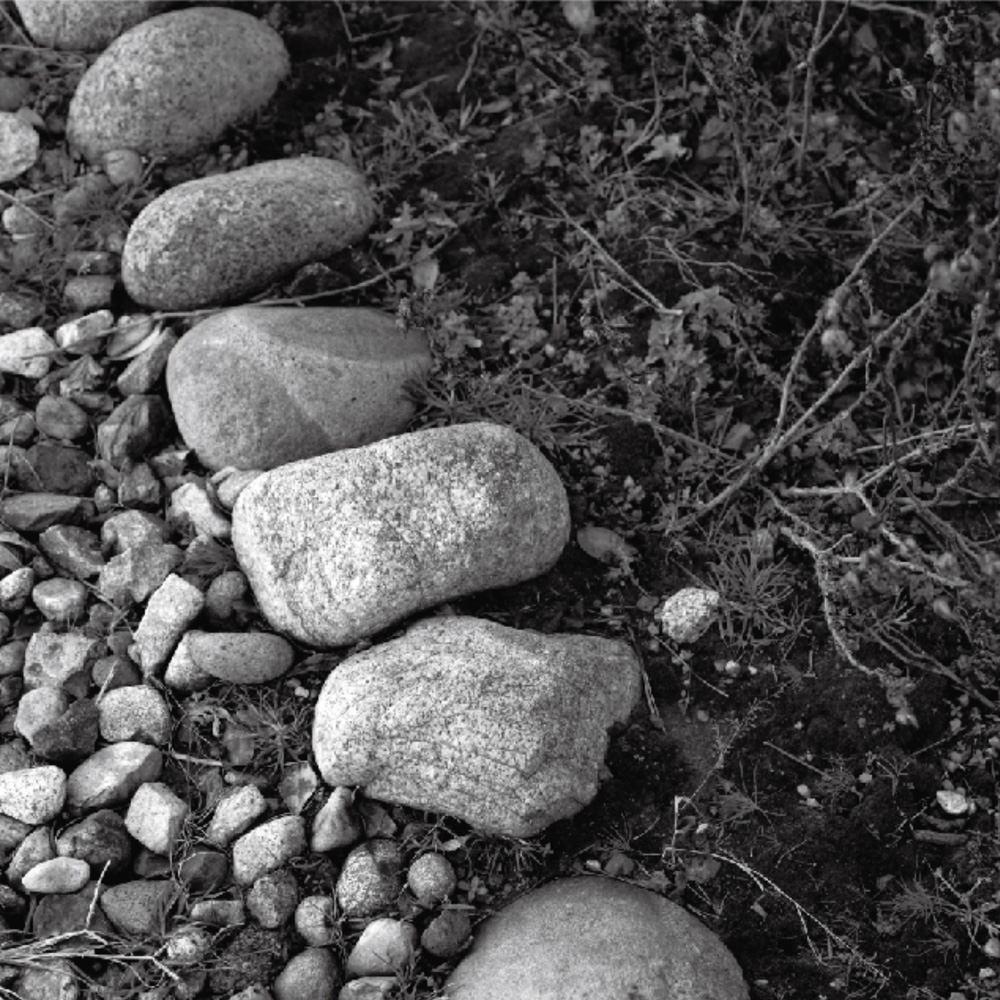photographs(73pieces)+mixed media
2016
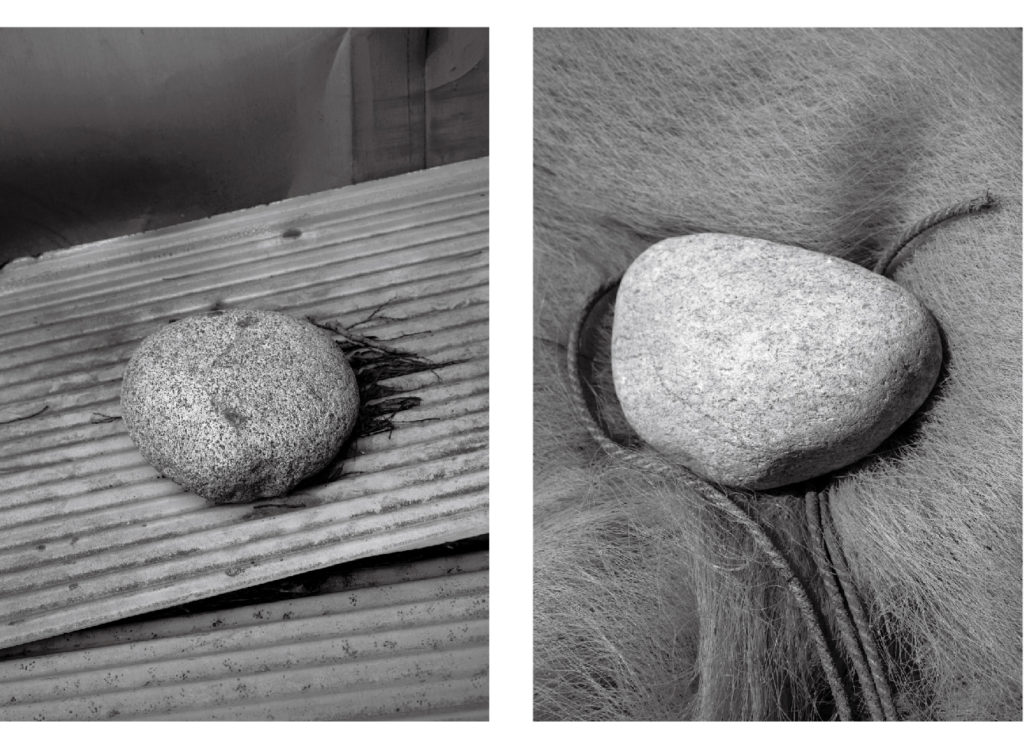

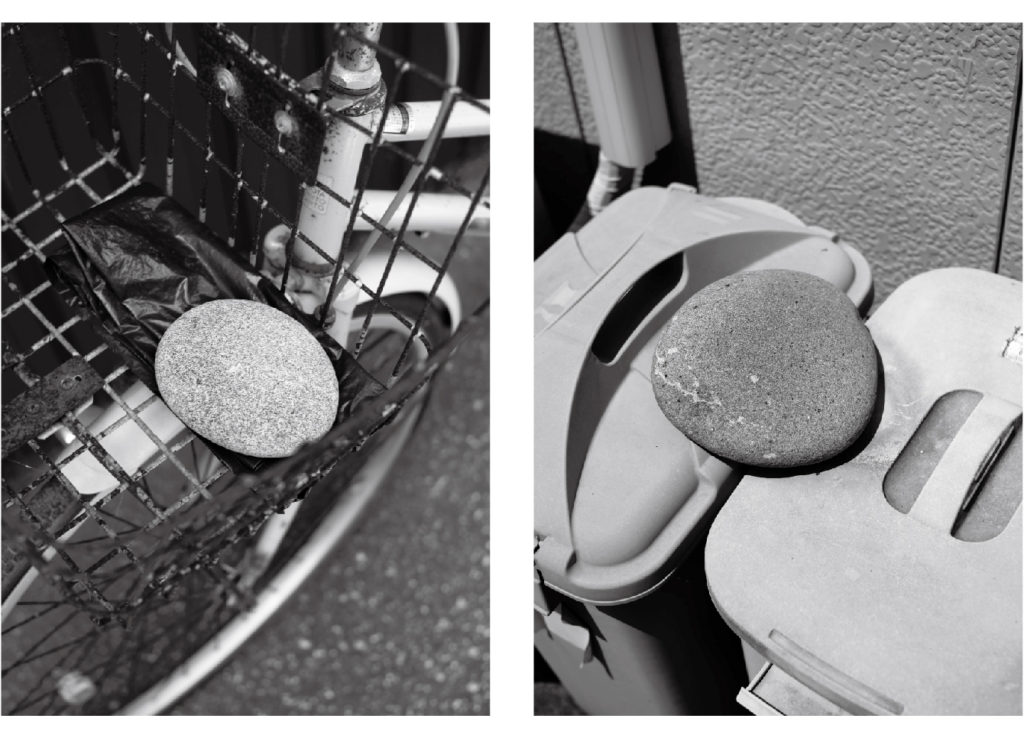
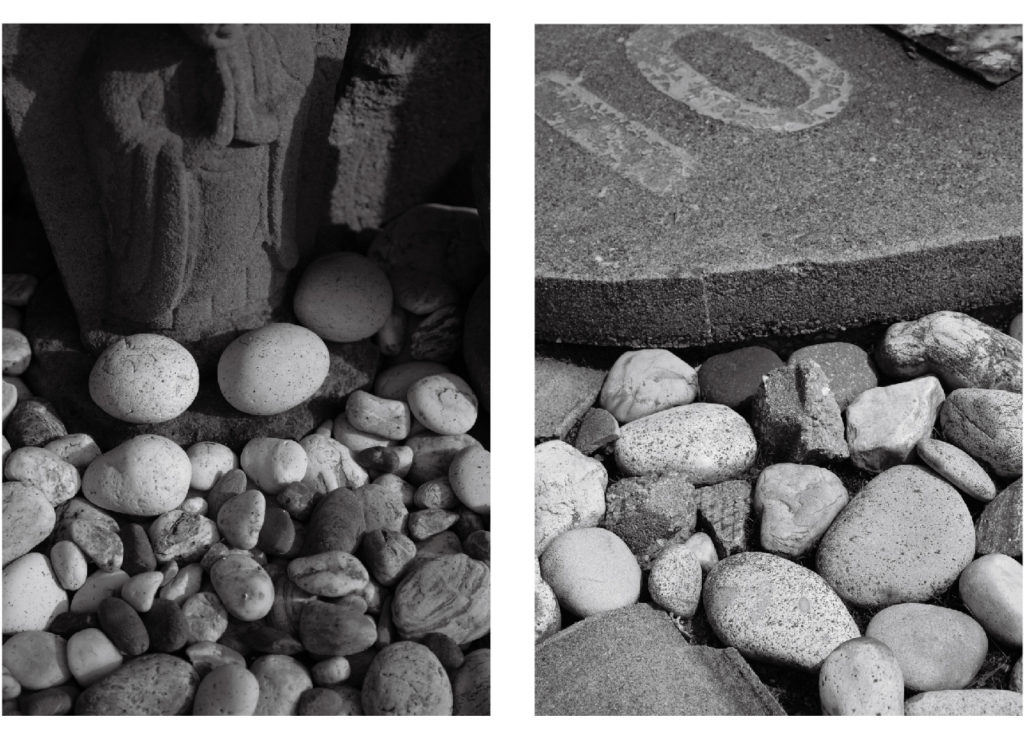
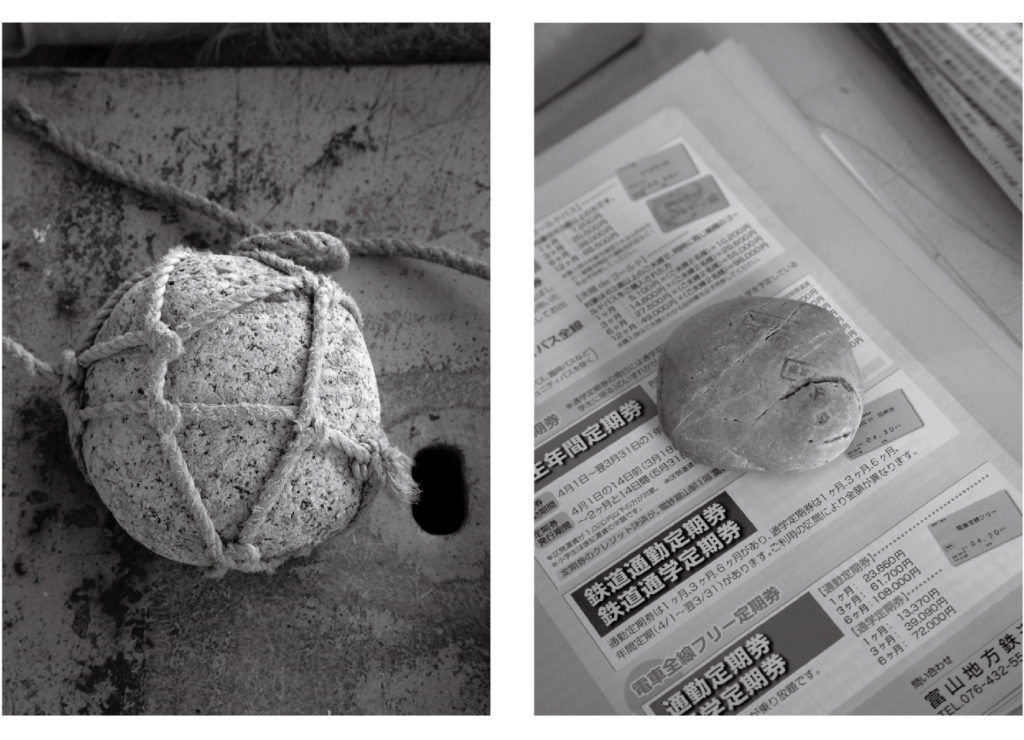
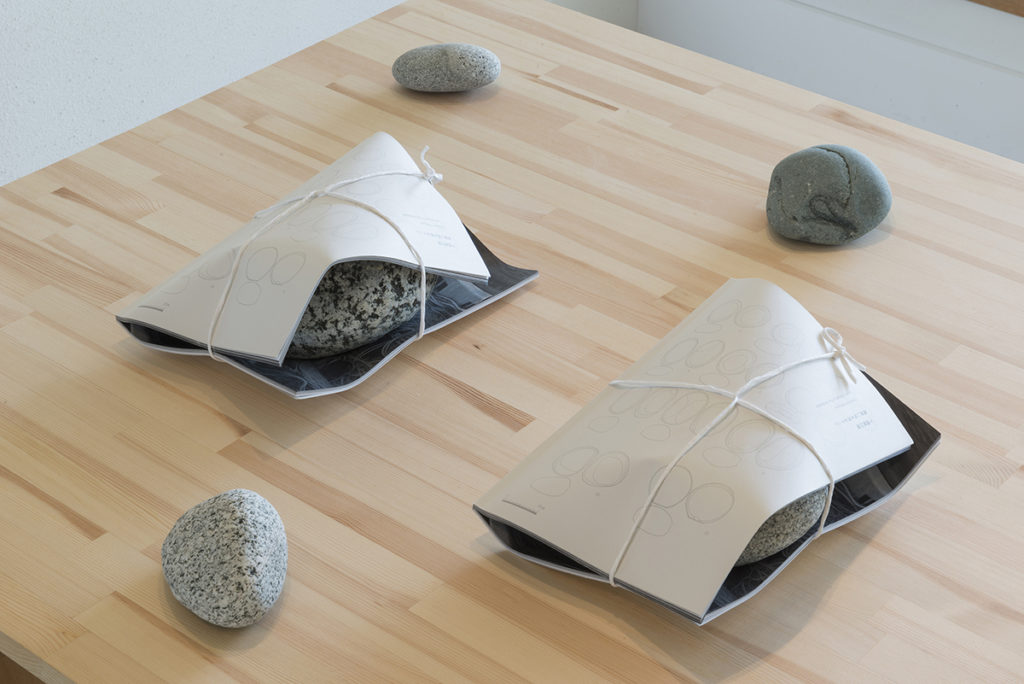
Photo book+Stone from beach (Kurobe City Art Museum)
海沿いを車で走っていた。
灰色に淀んだ空、そして降り積もる雪は、風景を白黒の写真のようにしている。目を細めると、ずっと遠い昔にタイムスリップするかのようだった。
ある集落で車を止めて浜辺に降りると、丸い小石の浜は、波が寄せる度にカラカラと寂しげな音を立てていた。
無数の石の中から、ふと目についた石ころを拾い上げた。小さな木星のような石。砂のような色がだんだん模様になっている。(薬石と呼ばれる石。微量の放射線が出ていて、地元の人はお風呂にいれるのだという)
浜辺には色や形、様々な石が転がっている。そのひとつひとつが別々の場所で何億年も前に生まれ、地層からはがれ落ち、コロコロと転がりながら膨大な時間をかけ、この欠片になり、今も目の前で波によって少しずつ削られ、この手の中にある。小さな石が持つ時間感覚の巨大さに畏れを感じてしまう。
浜辺から歩いて、集落の細い路地に迷い込む。
やがて様々な家の軒先で浜辺の石ころが使われていることに気がついく。ある石は海風から物が飛ばないように重しに、ある石は隣の家との境界や石垣に、ある石は美しかったからだろうか軒先に飾ってある。意識してみると路地は石ころだらけでおかしかった。
ちょうど取ってきたばかりらしき石が玄関に置いてある家を見つけ、玄関のチャイムを押してみる。怪しそうに出てきたご主人に「すみません…。この石は何に使うのですか?」と質問してみると、突然の質問に驚きながら「えっと…、漬け物石ですが……」と教えてくれる。
僕も幼い頃海の近くに住んでいたが、こんなにも石を利用している風景は始めてみたしとても面白い…、というようなことを伝えると、「石なんて、浜辺にいくらでもあるからね。みんな浜辺から持ってくる。でも、年々浜辺が痩せててね。あそこに防波堤が作られてからは海がよく見えなくなったけど、昔はここからも一面広い浜辺が見えてね、漁から帰ってきた船や地引き網で、いつも賑やかだったよ」
ご主人に連れられて、裏の倉庫の隅に行くと、昔の漁の錘(重り)であろう縄でしばられた石がゴロリと転がっている。その様子は、賑やかに活躍していた石が元の石に戻り、沈黙しているかのようだった。
この浜辺の近くからは、旧石器時代の石器や縄文時代の集落の跡等、古くからの人間の営みの痕跡が見つかる。さらにヒスイが寄せる浜もあり、古代には勾玉が作られた。今でもここで作られた勾玉は日本全国、遠くは朝鮮半島などでも発掘されるという。大昔もこうやって人々は石を探して浜辺を歩いていたのだろう、その頃から石は今のような石のままだったのだろう。
ある日、
洞窟に暮らしていた古代人たちが、いつも襲われていた猛獣に偶然石を投げつけた。石に武器の意味を見つけた人々はまたある日、投げつけた石が岩とぶつかり砕けて、先が尖っている様子を発見した。石の加工がはじまり、道具はゆっくりと時間をかけてさらに進化していった…………。
と、特急電車の中でこの文章を書いている。ポケットには、拾ったばかりの木星のような石ころ。僕は今、椅子に座った状態のまま、人間が力一杯投げた石ころの2倍以上の速度で移動している。車内は夜なのに明るく、座席は気持ちのいい角度に動くし、前の座席には収納式のテーブルやネット状の物入れまでついていて、後ろの席からは音楽プレーヤーの音が漏れてくる。
周囲を見渡すと、目につくあらゆる物には、それぞれ既に意味があり、僕たちは疑う事なくそれらをその意味で使い生活している。
そう考えると、石は今でもただの石であり、それだけでは意味や価値はない……ということが、ある意味ですごい事なのではないかと思えてくる。それぞれの石に価値を与えるのはそれを拾い上げた人間であるということ。
小さな惑星のような石ころは、宇宙の欠片であると同時に、その内側に無限の宇宙を閉じ込めているのではないか。
下道基行
I was driving my car along the coast of the sea. The dark gray sky, with the falling snow covering the ground makes the landscape appear to be a black and white photograph. As I survey the scenery through squinting eyes, I feel as though I have slipped back into a time long past. I stop my car at a village and make my way to the foreshore. Each time a wave surges to the shore, the small round pebbles on the beach rattle cheerlessly.
From the countless stones, I pick up one that grabs my attention. The stone has the appearance of a tiny Jupiter, its sandy colors making a pattern. (It is a stone known as yakuseki. Containing a small amount of radiation, the locals add such stones to their bath water.)
Stones of various shapes and colors lie on the beach. Each stone came into being hundreds of millions of years ago at some distant place. Each one flaking away from the earth’s layers, rolling through time to become the fragments they are today. Even today these stones are being eroded away by the waves before my very eyes. One of these stones sits in my hand. I am overawed by the enormity of the passage of time that this small stone has seen.
I walk away from the beach and find myself in a narrow lane in the village. It is not long before I notice that the stones from the beach have been used around many of the houses. Some stones are used as weights to keep objects from blowing away in the wind. Others are used to mark the boundary with the neighboring house, or as stone walls. Another, perhaps because it was beautiful, is simply used as a decoration. It seems quite funny when I realize that the lane is full of stones.
I find a house that has a stone sitting at the front door. It looks like it has just been brought up from the beach. I ring the front door bell. The owner answers the door, looking at me suspiciously.
“Excuse me. What are you going to do with this stone?” I ask.
“Well, I am going to use it when I make pickles,” he answers, surprised by the sudden question. I explain that even though I used to live near the sea when I was a child, I have never seen a landscape using as many stones as this, and I find it fascinating.
“There are more stones than you could possibly want for on the beach,” he said. “Everybody brings them home. But the foreshore is slowly disappearing year by year. Since the pier over there was built, we can no longer see the sea, but once we could see the beach spread out before us, even from here. It was always bustling with activity from boats returning from fishing, and people using dragnets along the shore.”
The man took me to a nook near his shed at the rear of the house. Stones that must have been used as weights for fishing were lying around, tied together with rope. It was as if stones that had once bustled with life had now returned to their natural state, once again silent.
Evidence of human activity from ancient times, such as the ruins of a village from the Jomon Period, and stone implement artifacts from the Paleolithic Age, can be found in areas neighboring the beach. There are also beaches where jade is washed up, and in ancient times it was used to make comma-shaped beads. Even now, those beads can be found all over Japan, and even as far away as the Korean Peninsula. In days gone by, people must have also walked these same beaches searching for stones in much the same way as people do now, and the stones from those times are the same as stones here now.
One day, the cave-dwelling ancients just happened to throw stones at one of the wild animals that always attacked them. Then another day, the people who thought to use stones as a weapon, discovered that the stone they had thrown had hit a boulder and split, and now the edges of the stone were sharp. The process of manipulating stones began, and slowly with time, tools evolved.
I am writing this essay on the train. I have the Jupiter-like stone in my pocket. I am at this moment, while sitting in my seat, travelling at a speed twice as fast as any man could possibly throw a stone. Though it is dark outside, the train carriage is brightly lit. The chair reclines to a comfortable angle. There is a small stowaway table, and a pocket on the back of the seat in front of me. I can hear music spilling over from somebody’s music player behind me.
As I look around me, each and every item my eyes rest upon already has a meaning or role, and we do not doubt that, using each item as was intended in our daily lives. To think in this way, a stone is simply a stone. In this sense, it has no meaning or value. However, in many ways, a stone can be an amazing object. What provides each stone with its value, is the person who picks it up. This small, planet-like stone is both a fragment of the universe, and also has an infinite universe trapped within it.
This book comes with a bonus stone.
Or perhaps this stone comes with a bonus book.
What stories will the stone whisper to you?
The answers are within you.
Motoyuki Shitamichi
